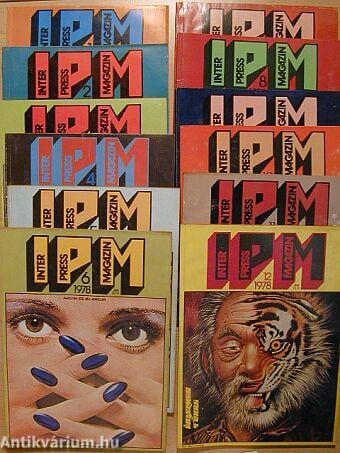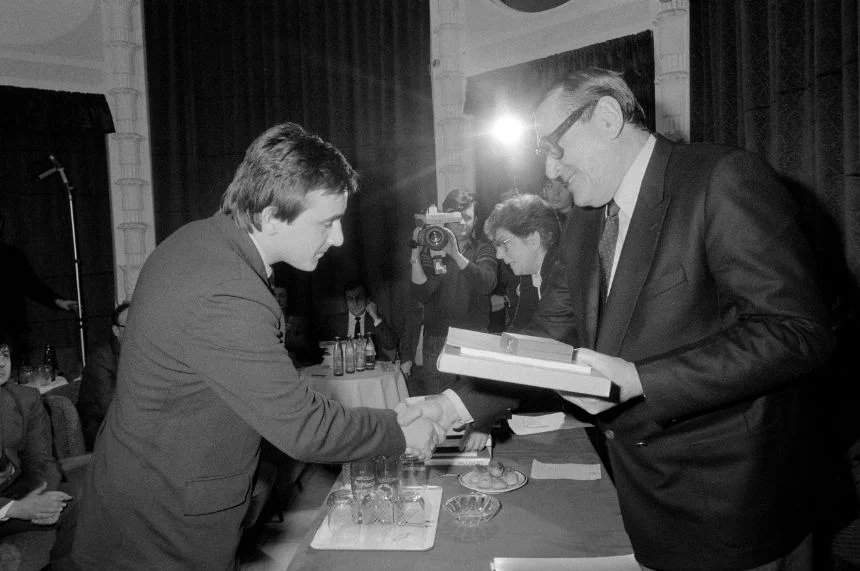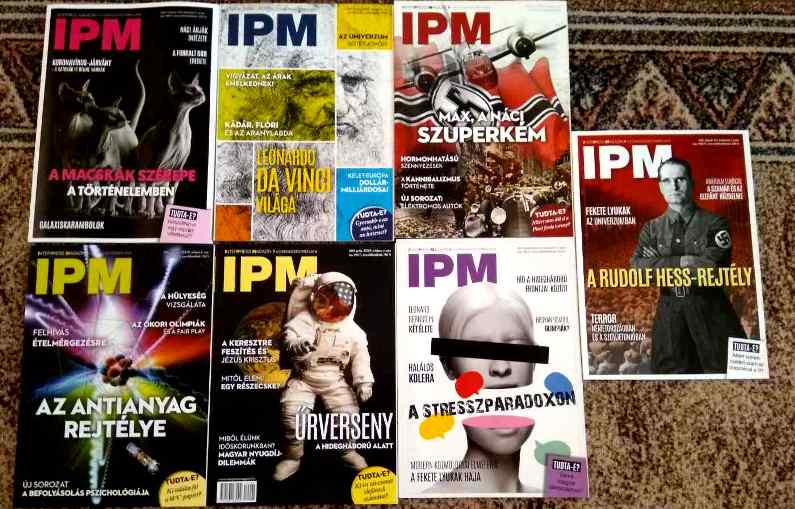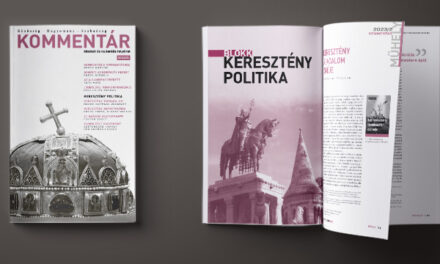The historian Zsuzsanna Borvendég's series was originally published on the PestiSrácok website, but there are certainly those who missed it. But those who haven't read all the parts should also read it again. Knowing the whole picture, can we understand how we got here?
Anyone who can remember the seventies and eighties does not need to be introduced to Interpress Magazin (IPM) and Alfa. Alfa Magazin was the children's publication of IPM. Both publications were a window full of colorful, sophisticated, exciting and beautiful photos to a world that was only available to a few in Hungary at the time.
What did turning these glossy pages mean to me as a child? A wormhole that took me in an instant in the curved space from my ruined panel room to the glittering luxury life, where Hollywood and the Kenyan savannas, the Danish Lego city and the endless Australian plateau were within arm's reach. An imaginary journey through space and time - with the help of the KGB.
The publisher of IPM was the economic enterprise of the International Journalists' Organization (NÚSZ), which operated as a cover organization for the KGB. The financial center of NÚSZ operated in Prague under the name Videopress. In a previous article, you could already read that, as a servant of Soviet imperialist interests, NÚSZ carried out many economic activities – legal and illegal – among the enterprises was the publication of a profile-cutting newspaper, with which they killed two birds with one stone: they generated money and spread ideology .
A drop of capitalism in the party state
Norbert Siklósi the MÚOSZ started to serve the interests of the Soviet secret service, which did not only mean the fulfillment of intelligence tasks, but also actively helped to create the economic background. From 1966, the general secretary of the MÚOSZ became the treasurer of the NÚSZ, that is, he became one of the managers of the secret financial affairs. It is therefore not surprising that the Prague center also began to expand in Budapest: the Interpress Printing and Publishing Company was formed. According to the charter, the company was established on December 21, 1970. Its scope of activities was defined within a fairly broad framework, so that in addition to printing and publishing activities, it included almost anything that NÚSZ wanted to deal with in Hungary or elsewhere. The maintenance of social institutions, the production and distribution of films, the support of "advanced journalistic movements" maintained by NÚSZ, and the exercise of independent foreign trade rights for unspecified products were among the company's duties, as were the agency activities related to NÚSZ's cultural policy tasks and occasional activities according to the founder's decisions. activity. Of course, business operations were not limited to the socialist market, partners were sought among the more solvent capitalist states.

IPM
The company's task was primarily to raise money for the implementation of the Soviet policy of influence - specifically to support left-wing movements in Africa, to maintain the NÚSZ journalism school and the Paris office - and it would not have been enough to simply publish newspapers, as was obvious. into the profile of a journalist organization. A significant part of the company's income did not come from newspaper publishing, but from other economic activities, although the Budapest company published the only newspaper of NÚSZ, the Hungarian Interpress Magazin, which did not have a subscription fee. In fact!
Progressive journalists, unite!
The magazine was originally published in Prague, and its Hungarian version gained importance in media history in terms of its readership. The legendary magazine was launched in January 1975, initially with a bimonthly publication. Its editor-in-chief István Ivanics , who obviously did not get into this position by chance. According to his own account, he previously worked as the editor-in-chief of Világ Jújúság of the Democratic Youth World Federation (DIVSZ), which itself was created as a mass organization of Bolshevik influence and propaganda after the Second World War. The NÚSZ and the DIVSZ were sister organizations in terms of the final goals, and certainly not only the goals, but also the methods were very similar to each other. From 1975, Ivanics therefore worked not for the youth of the world, but for the unification of the world's journalists , and for this the magazine he edited generated a huge fortune at the expense of NÚSZ. In his reminiscences, he revives the founding of the paper as a clever evasion of the authorities, which seems somewhat ridiculous given the background. Not only because of the presence of the KGB, but also from the listing of the names of the licensers and supporters, the top level of the party management of the media at that time is revealed: Péter Várkonyi , who was then the president of the Information Office of the Council of Ministers, Ferenc Simon , the deputy president of the Information Office, and Ernő Lakatos , of the Central Committee of the MSZMP The head of the Agitation and Propaganda Department supported Ivanics in starting the IPM.

Budapest, February 13, 1986. Lajos Weber, photojournalist of the Hungarian Telegraph Office (MTI), receives the gold medal of the International Journalist Organization Interpress Photo '85 competition from Jiri Kubka, secretary general of the International Journalist Organization, at the Hungarian Press House. MTI Photo: Péter E. Várkonyi
The paper had a dizzying career. In the first year, the name of none other than István Ivanics was listed in the imprint, however, parallel to the increase in popularity, the actual editorial board also appeared, who jointly gave their names to the Prague and Budapest papers: dr . Milan Codr, Ferenc Greguss, István Ivanics, dr. Irén Lőrincz and Jaroslav Pikous. participate in the work as civilians, but - according to István Ivanics' memories - , but according to János Pelle's they were members of the Czechoslovak state security. The responsible publisher György Stark , director of Interpress.
The magazine owes its popularity to the fact that, at least apparently, it was published as a non-political, colorful, high-quality magazine, which was completely missing from the Hungarian newsstands. In addition, it started with a capitalist type of business policy from the first moment, since it had to generate money, thus filling the void in the Hungarian advertising market. too. The number of copies reached its peak in the mid-eighties, when 170,000 people could read the magazine at the same time, but soon the children's newspaper Alfa was also published, which was also published in the order of 100,000. The great popularity also brought great profits, according to Ivanics, by 1988, IPM had already generated a profit of fifty million forints (considered a huge amount at the time), the entire amount of which was transferred to the account of NÚSZ until 1987-1988. At this time, Interpress also started to deal with book publishing, primarily trying to distribute the also highly profitable paperback literature, which was in short supply. Within the entertainment industry, newspaper and book publishing was a fairly profitable business in the 1980s, as the state subsidized it significantly, and electronic media was not considered a serious competitor even then.
The night club and accounting
Regarding the personnel of Interpress Vállalat, The director of the company is György Stark, MNVK-2. (military intelligence) who studied as a printer's bookbinder and worked at MÚOSZ from 1959. The position of deputy director György Bárdos , who was not directly connected with state security, but his brother was in the III/I. He was an officer of group leadership. Bárdos was fired from Interpress in 1974. It is not possible to know what was the cause of the conflict, but Bárdos may have left offended, as he filed a complaint with the Ministry of Finance regarding the dubious financial maneuvers of Interpress. The investigation was started, but of course there were no consequences - not by chance. Tibor Éles , who was the head of the MÚOSZ department responsible for international affairs and, incidentally, an officer in the top secret staff of the Ministry of the Interior, the ministerial investigation was directed by the head of the department for military and other secret topics - and he was cleared.

An unforgettable IPM cover
The role of the NÚSZ inspector posted to Budapest was played by dr. Béla Aczél . For the time being, we have little information about him, but we do know that he worked with all his might to smooth over the scandals surrounding Interpress. In 1974, when György Bárdos filed a report, the ministerial auditors and the auditors from Prague mostly conducted the audits at the Maxim entertainment venue , where Béla Aczél hosted them. We can imagine the cheerful atmosphere of the financial analyzes that took place in the night club...
Suspicious payments - obscure tasks
The most mystified and least known department of Interpress by contemporaries was the Press Documentation Research Center, Gyula Dersi . "No one at the company knows what they were up to. This institute went out of business without doing anything. The daughter of Piroska Szemes [journalist, columnist for Nők Lapja] worked at this institute, whose mother went to her daughter's workplace to explain why her young daughter received such a high salary, fearing that some criminal activity might be behind it. " – can be read in the analysis of state security. BM's confusion becomes really interesting when we add that Dersi was their agent, who reported on everything except Interpress in a tongue-in-cheek manner. Thus, all we know is that this particular Press Documentation Research Center originally belonged to the MÚOSZ, where it operated under the name of the NÚSZ Communication and Propaganda Office, and then was organized under Interpress in 1973.
Agents and touts everywhere
The Publishing and Printing Department was headed by István Várkonyi. This department dealt with the publication of the papers published by Interpress. István Várkonyi was previously the editor-in-chief of Népszava. The Audiovisual Department was headed by Árpád Kató , former chef of the NÚSZ resort in Balatonszéplak. This was probably one of the departments that generated the most money, since they distributed the collected advertisements, for example, by traveling around the country in minibuses and organizing slide film screenings of a few minutes in different parts of the country, naturally in busy places, especially in subways in Budapest. Already in the early seventies, they were able to generate a profit of HUF 5-6 million per year from the distribution of these commercials.
The collection of advertisements was handled by the Department of Commerce and Organization, which also had rural units, since regional representatives kept in touch with the various companies from which they expected advertising orders. Its leader Sándor Dénes , who, according to the contemporary records of the BM, served as an investigator at the Budapest Headquarters of the Hungarian State Police in 1945, and was later an agent of the political police. István Rényi , who was also party secretary of the company and previously served in the Military Defense Department of the ÁVH, worked together with Dénes
From Interpress to Creditum
We have significantly less information about the Photo Department, we can only know for sure that " János Komlós ." Yes, that's János Komlós. The director of Mikróskók Színpad, who worked for the state defense since 1945. In 1953, he was dismissed from the ÁVH, in 1956 he was taken back into the secret staff by the Ministry of the Interior's counterintelligence, and he was appointed head of the Protocol Department of the Ministry of Foreign Trade. During his later cultural career he remained a reserve officer of the BM , and thanks to his connections he managed to secure the career of his son, who, starting from the NÚSZ company, took him all the way to the co-ownership of the financial company Creditum, founded in 1988 by György Bajnai , the father of the later prime minister From a financial point of view, the Interpress Film Studio played an important role, the first manager of which was György Falus was succeeded by Dezső Jutasi Their task was primarily to enrich NÚSZ's account by making commercial films, but they were not only involved in shooting short films of a few minutes, but also supported the production of feature films, both at home and in the West. According to counterintelligence data, both heads of the film department had secret service backgrounds.
Source: PestiSrácok
Author: historian Zsuzsanna Borvendég
(Cover image source: Vatera)












